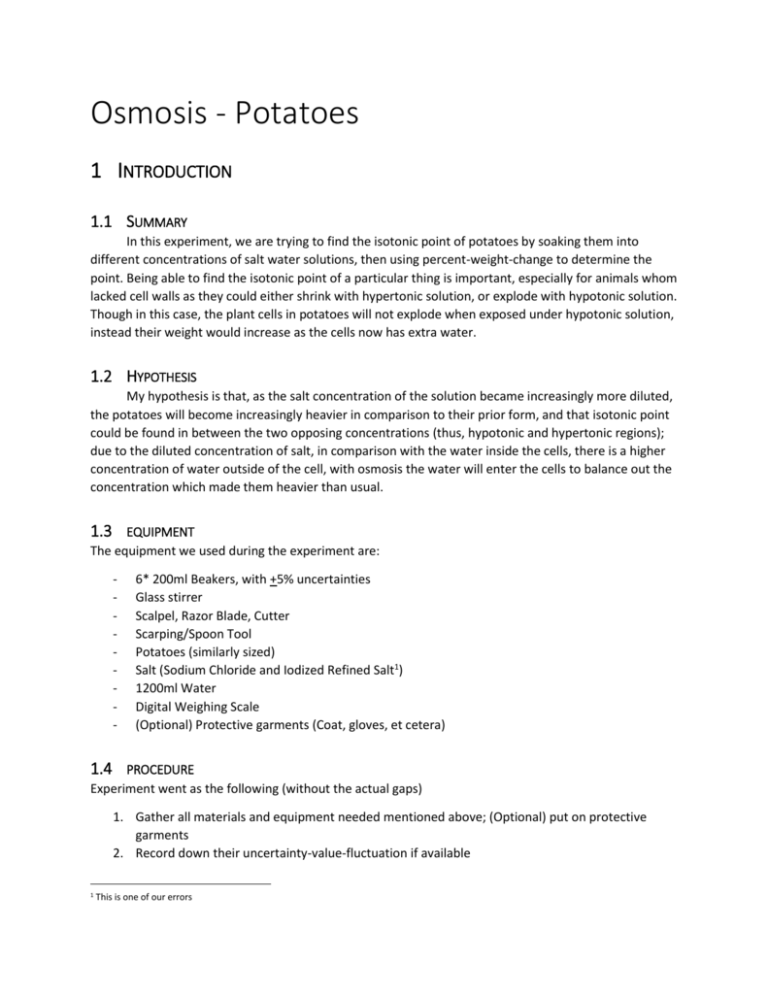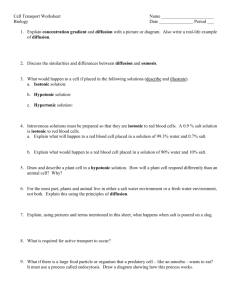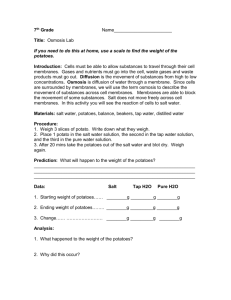Osmosis in Potatoes: Finding the Isotonic Point
advertisement

Osmosis - Potatoes 1 INTRODUCTION 1.1 SUMMARY In this experiment, we are trying to find the isotonic point of potatoes by soaking them into different concentrations of salt water solutions, then using percent-weight-change to determine the point. Being able to find the isotonic point of a particular thing is important, especially for animals whom lacked cell walls as they could either shrink with hypertonic solution, or explode with hypotonic solution. Though in this case, the plant cells in potatoes will not explode when exposed under hypotonic solution, instead their weight would increase as the cells now has extra water. 1.2 HYPOTHESIS My hypothesis is that, as the salt concentration of the solution became increasingly more diluted, the potatoes will become increasingly heavier in comparison to their prior form, and that isotonic point could be found in between the two opposing concentrations (thus, hypotonic and hypertonic regions); due to the diluted concentration of salt, in comparison with the water inside the cells, there is a higher concentration of water outside of the cell, with osmosis the water will enter the cells to balance out the concentration which made them heavier than usual. 1.3 EQUIPMENT The equipment we used during the experiment are: - 6* 200ml Beakers, with +5% uncertainties Glass stirrer Scalpel, Razor Blade, Cutter Scarping/Spoon Tool Potatoes (similarly sized) Salt (Sodium Chloride and Iodized Refined Salt1) 1200ml Water Digital Weighing Scale (Optional) Protective garments (Coat, gloves, et cetera) 1.4 PROCEDURE Experiment went as the following (without the actual gaps) 1. Gather all materials and equipment needed mentioned above; (Optional) put on protective garments 2. Record down their uncertainty-value-fluctuation if available 1 This is one of our errors 3. Using available cutters (Scalpel, Razor Blade, Cutter) to slice the potatoes into 6 groups of 3 slices with semi-even slices 4. Weigh the 6 groups of potatoes with the Digital Weighing Scale, record the result 5. Prepare all 6 200ml-beakers, rinse them with water, then fill them up to approximately 200ml each 6. Calculate the amount of salt needed for each concentration (starting from 0 mol of salt used to 1 mol, with each incensement of 0.2 mol); we have reduced the amount needed by a fifth, thus 200ml water with 11.69g salt for 1 mol solution a. 0 mole solution requires 0g of salt b. 0.2 mole solution requires ~2.338g of salt (Iodized Refined Salt) c. 0.4 mole solution requires ~4.676g of salt (Iodized Refined Salt) d. 0.6 mole solution requires ~7.014g of salt (Iodized Refined Salt) e. 0.8 mole solution requires ~9.352g of salt (Iodized Refined Salt) f. 1 mole solution requires ~11.69g of salt (NaCl) 7. Pour in the needed salt with the help of scraper, then use glass stirrer to help dissolve the salt quicker 8. Make sure majority of the salt were dissolved, then simultaneously place the sliced potatoes into all six solutions for 20 minutes 9. After 20 minutes had passed, simultaneously take out the potatoes and shake off the excess water without the use of any dry objects (such as tissue paper) 10. Weigh them by groups again on the digital weighing scale, record the results 11. Clean up beakers, equipment used, table, et cetera 2 RESULTS 2.1 RESULTS AND OBSERVATION Here is the raw data table with the weight of the potatoes in pre-experiment and post-experiment forms Weight Change of Potatoes Potatoes by Pre-experimental Weight (g) Post-experimental Weight (g) Solution (mole) 0.0 20.58 21.90 0.2 17.91 18.03 0.4 23.11 21.47 0.6 17.97 15.73 0.8 20.07 17.80 1.0 28.92 24.61 In this case, the independent variable is the different concentrations of salt water, with dependent variable of percent weight change. When the potatoes were first cut, there were liquids leaking out from the cut surface, in which after approximately two to three hours later, the slices became dry and “shrunk” slightly after losing water, thus the texture on the cut became rougher. Flexibility of the slices did not change much, those exposed in hypotonic solutions became slightly tougher (not easily bent), those in hypertonic solutions became slightly more flexible; as cells exposed to hypotonic solutions will carry more water, thus expanding its size may reduce the space in between the potatoes; those exposed to hypertonic solutions shrinks in size and increases the spaces in between each cells, with extra spacing, they are more flexible when bent. Aside from such, the weight difference is not too significant (ranging from 1g ~ 4g) as we have only left it in the solutions for twenty minutes. 2.2 DATA PROCESSING Here is the table along with the weight change in percentages. Math is done by so: [(Weight After – Weight Before) / Weight Before] * 100% Weight Changes of Potatoes Potatoes by Pre-experimental Weight Post-experimental Weight Solutions (mole) (g) (g) 0.0 20.58 +0.01 21.90 +0.01 0.2 17.91 +0.01 18.03 +0.01 0.4 23.11 +0.01 21.47 +0.01 0.6 17.97 +0.01 15.73 +0.01 0.8 20.07 +0.01 17.80 +0.01 1.0 28.92 +0.01 24.61 +0.01 *Note: Due to spacing issue, graphs will be attached at the end of the report Percent Weight Change (%) 6.41 0.67 -7.10 -12.47 -11.31 -14.90 With the graph above, we could know approximately where the isotonic point for potatoes are, thus around 0.25 mole worth of salt solution with ~200ml water mixed with ~2.338g salt. The beakers used has a value of uncertainty of approximately +5%, thus we could assume that the water volume we have actually filled in is at minimum 190ml and maximum 210ml; or simply put 200ml +10ml. For the weight, the digital scales calculates up to two decimals, so we could assume the uncertainty fluctuation value is +0.01g. 3 CONCLUSION The experiment confirmed that my hypothesis is half correct, that as the salt concentration of the solution became increasingly more diluted, the potatoes will become increasingly heavier in comparison to their prior form, and that the point of balance could be found in between the two opposing concentrations. Under the exposure to hypotonic solutions with increasingly higher concentration of water, through osmosis, water moves from the solution into the cells for balance, leading to increase in size proven through slightly more rigid slices, and increase in weight through measurements. What I did not hypothesize was the weight loss under exposure to increasingly concentrated salt water solutions; as the solutions became more concentrated, in comparison with the plant cells it became a hypertonic solution, thus through osmosis water moved from the cells out towards the solutions, causing shrink in size proven through slightly more flexible slices, and decrease in weight through measurements. After the data were collect and organized into a graph, the approximate value for an isotonic point for potatoes is about 0.147 mole concentration. This is done through the usage of percent weight change, wherever the change is 0% it is considered as balanced, due to equal movements between potatoes and solutions that does not cause any change in weight. Given this, we could assume the region greater than 0.147 mole is hypertonic, and region lesser than 0.147 mole is hypotonic to potatoes. Overall the graph shows a negative linear relationship between percentage-weight-change over molar concentration, thus as percent weight change increases, molar concentrations decreases and vice versa; thus proving my hypothesis to be half correct. 4 ANALYSIS 4.1 ERRORS In general the experiment went as the procedures without major errors, though we did have quite a few errors made throughout the entire experiment. First, sliced potatoes were left exposed to the air for an extended period of time, which might cause internal water loss leading to different water quantity in comparison with the uncut ones. Second, the potatoes were cut unevenly causing difference in weight and thickness, resulting in different rate of liquid movements (thicker ones would require more time to absorb as much water as the thinner ones could with shorter duration needed). Third, used glass stirrers was not cleaned after used for a solution, resulting in leakage of other solutions that would alter the actual concentration for the solution being mixed. Fourth, sliced potatoes were not placed in and taken out simultaneously, resulting in slight difference in movement rate. Fifth, two types of salt are used, Sodium Chloride and Iodized Refined Salt, which would change the results as the salt within the cells is different from Iodized Refined Salt; salt might not completely dissolved after stirred, resulting in slight difference in concentration. Sixth, excess water from the potatoes is not completely shaken off, causing slight, extra weight on the weighing scale. Seventh, we could not achieve a complete transfer of measured materials (salt, water), thus leading to loss of materials in slight quantity that causes slight difference in result. Then the uncertainty errors that occurred during the usage of equipment. First, some beakers used were not completely rinsed, resulting in impure solution that may carried other substances along with the solution. Second, beakers used has uncertainty of +5% value fluctuation, resulting in flawed measurement of the water volume needed. Third, digital scales measured up to two decimals, thus contains a minimum +0.01g value fluctuation that would have slightly affect the final results as the measurements were not exact. 4.2 GRAPH QUALITY The graph itself in general could be improved. The scale of both axis was made to reduce the scaling to as little as possible without complicating the scaling, resulting in a decently sized graph to which we could approximate the isotonic point up to thousandth place. But analyzed data were up to hundredth place, thus these points were only precise up to tenth place while the hundredth place were estimated.






